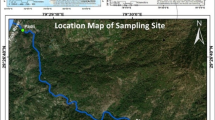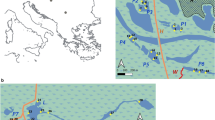Abstract
The species diversity of phyto- and zooplankton, benthic animals, and ichthyofauna was studied in continental water bodies that differ in type, geographic location, size, and productivity. The results showed that the number of species in the communities of aquatic organisms and in ecosystems depends on the area and volume of the water body and the level of plankton primary production. Corresponding relationships can be approximated by the equations of exponential and polymodal functions. The species number and biomass per unit area or volume proved to decrease as the area or volume of the water body increased. The greatest number of heterotrophic species was observed in water bodies whose primary production approached 1400 kcal/m2 per year. It is proposed that the number of aquatic species in a body of water depends on the total area of the latter and the area of individual territories occupied by the representatives of certain species.
Similar content being viewed by others
REFERENCES
Alimov, A.F., Diversity in Animal Communities and Its Conservation, Usp. Sovrem. Biol., 1993, vol. 113, pp. 652-658.
Antropogennoe evtrofirovanie Ladozhskogo ozera(Anthropogenic Eutrophication of Lake Ladoga), Leningrad: Nauka, 1982.
Antropogennoe vliyanie na krupnye ozera severo-zapada SSSR(Anthropogenic Effects on Large Lakes of the Northwestern Soviet Union), Leningrad: Nauka, 1981, part 2.
Barbour, C. andBrown, J.H., Fish Species Diversity in Lakes, Am. Nat., 1974, vol. 108, pp. 473-489.
Biologicheskaya ‘Produktivnost’ pelagiali Baikala i ee izmenchivost' (Biological Productivity of the Pelagic Zone of Lake Baikal and Its Variability), Novosibirsk: Nauka, 1977.
Biologicheskaya ‘Produktivnost’ severnykh ozer (Biological Productivity of Northern Lakes), Leningrad: Nauka, 1975.
Biologicheskie resursy Ladozhskogo ozera (zoologiya)(Biological Resources of Lake Ladoga: Zoology), Leningrad: Nauka, 1968.
Bioticheskie vzaimootnosheniya v ekosistemakh ozer-pitomnikov(Biotic Relationships in Lakes Used as Fish Nurseries), St. Petersburg: Gidrometeoizdat, 1993.
Brönmark, Ch., Freshwater Snail Diversity: Effect of Pond Area, Habitat Heterogeneity, and Isolation, Oecologia(Berlin), 1985, vol. 67, pp. 127-131.
Carney, H.J., Food Web Approaches to Biodiversity Studies and Conservation, Verh. Int. Verein. Limnol., 1998, vol. 26, pp. 2409-2412.
Connor, E.F. andMcCoy, E.D., The Statistics and Biology of the Species-Area Relationship, Am. Nat., 1979, vol. 113, pp. 791-833.
Connor, E.F.,McCoy, E.D., andCosby, B.L., Model Discrimination and Expected Slope Values in Species-Area Studies, Am. Nat., 1983, vol. 122, pp. 789-796.
Dodson, S., Species Richness of Crustacean Zooplankton in European Lakes of Different Sizes, Verh. Int. Verein. Limnol., 1991, vol. 24, pp. 1223-1229.
Dodson, S., Predicting Crustacean Zooplankton Species Richness, Limnol. Oceanogr., 1992, vol. 37, no. 4, pp. 848-856.
Ecology of Eutrophic, Subarctic Lake Myvath and River Laxa, Oikos, 1979, vol. 32.
Ecology of Oligotrophic, Subarctic Lake Thingvallavath, Iceland, Oikos, 1992, vol. 64.
Ecosystems of the World. Lakes and Reservoirs, Amsterdam, 1984, vol. 25.
Ekologisheskaya sistema Narochanskikh ozer(The Ecological System of Narochanskie Lakes), Minsk: Universitetskoe, 1985.
Ekosistema Onezhskogo ozera i tendentsii ee izmeneniya(The Ecosystem of Lake Ladoga and Trends in Its Dynamics), Leningrad: Nauka, 1990.
Gidrobiologiya ozer Vozhe i Lacha v svyazi s prognozom kachestva vod, perebrasyvaemykh na yug(Hydrobiology of Lakes Vozhe and Lacha in Relation to Prognosis of the Quality of Waters Transferred to the South), Leningrad: Nauka, 1978.
Gidrobiologiya vodoemov-okhladitelei teplovykh i atomnykh elektrostantsii Ukrainy(Hydrobiology of Cooling Reservoirs of Ukrainian Thermal and Nuclear Power Plants), Kiev: Naukova Dumka, 1991.
Hobbie, J.E., Arctic Limnology: A Review, Alaskan Arctic Tundra. Arct. Inst. N. Am. Tech. Pap., 1973, vol. 25, pp. 127-168.
Issledovanie vzaimosvyazi kormovoi bazy i ryboproduktivnosti na primere ozer Zabaikal'ya (Analysis of the Relationship between Food Supply and Fish Productivity: An Example of Transbaikalian Lakes), Leningrad: Nauka, 1986.
Izmenenie struktury ekosistem ozer v usloviyakh vozrastayushchei biogennoi nagruzki(Structural Changes in Lake Ecosystems under Conditions of Increasing Biogenic Load), Leningrad: Nauka, 1988.
Kakhovs'ke vodoimishche, gidrobiologichnii naris (The Kakhovskoe Reservoir: A Hydrobiological Essay), Kiev: Naukova Dumka, 1964.
Khailov, K.M.,Prazukin, A.V.,Minkina, N.I., andPavlova, E.V., The Concentration and Functional Activity of Living Matter in Condensation of Different Organization Levels, Usp. Sovrem. Biol., 1999, vol. 119, pp. 3-14.
Kuibyshevskoe vodokhranilishche(The Kuibyshevskoe Reservoir), Leningrad: Nauka, 1983.
Lake Baikal and Its Life, Monographiae Biological, Kozlov, M., Ed., The Hague: Dr. W. Junk, 1984, vol. 11.
Martin, Th.E., Species-Area Slopes and Coefficients: A Caution on Their Interpretation, Am. Nat., 1981, vol. 118, pp. 823-837.
Minns, Ch.K., Allometry of Home Range Size in Lake and River Fish, Can. J. Aquat. Sci., 1995, vol. 52, pp. 1499-1508.
Moskalenko, B.K. andVotintsev, K.K., Biological Productivity and Balance of Organic Substance and Energy in Lake Baikal, Proc. IBR-UNESCO Symp. on Productivity Problem of Fresh Waters, Kazimierz Dolny, Poland, May 6-12, 1970, Warszawa, 1972, pp. 207-226.
Ozera Karel'kogo peresheika (Lakes of the Karelian Isthmus), Leningrad: Nauka, 1971.
Ozera Khakasii i ikh rybokhozyaistvennoe znachenie(Lakes of the Khakass Autonomous Region and Their Significance for Fishery), Krasnoyarsk, 1976.
‘Produktivnost’ ozer vostochnoi chasti Bol'hezemel'koi tundry (Lake Productivity in the Eastern Bol'hezemel'kaya Tundra), Leningrad: Nauka, 1976.
Putoranskaya ozernaya provintsiya(The Putoran Lake Province), Novosibirsk: Nauka, 1975.
Reaktsiya ekosistem ozer na khozyaistvennye preobrazovaniya ikh vodosborov(Response of Lake Ecosystems to Industrial Development in Their Catchment Areas), Leningrad: Nauka, 1983.
Reaktsiya ozernykh ekosistem na izmeneniya bioticheskikh i abioticheskikh uslovii(Response of Lake Ecosystems to Changes in Biotic and Abiotic Conditions), St. Petersburg: Nauka, 1997.
Sostoyanie myagkovodnykh ozer Estonii(The State of Soft-Water Lakes in Estonia), Tartu, 1991.
Stella, F. andMargaritoria, F., A Contribution to the Study of Lago Monterosi (Roma, Italy): A Present Biological Condition of the Lake, Verh. Int. Verein. Limnol., 1966, vol. 16, pp. 83-88.
Sugihara, G., S =CAZ, Z = 1/4: Reply to Connor and McCoy, Am. Nat., 1981, vol. 118, pp. 790-793.
Trifonova, I.S., Ekologiya i suktsessii ozernogo fitoplanktona(Ecology and Successions in Lake Phytoplankton), Leningrad: Nauka, 1990.
Vodokhranilishcha Moskvoretskoi vodnoi sistemy(Reservoirs of the Moscow River System), Moscow: Mosk. Gos. Univ., 1985.
Welch, Y.E. andKalff, J., Benthic Photosynthesis and Respiration in Char Lake, J. Fish. Res. Board Can., 1974, vol. 31, pp. 609-620.
Author information
Authors and Affiliations
Rights and permissions
About this article
Cite this article
Alimov, A.F. Studies on Biodiversity in the Plankton, Benthos, and Fish Communities, and the Ecosystems of Fresh Water Bodies Differing in Productivity. Biology Bulletin 28, 75–83 (2001). https://doi.org/10.1023/A:1026614906253
Issue Date:
DOI: https://doi.org/10.1023/A:1026614906253




